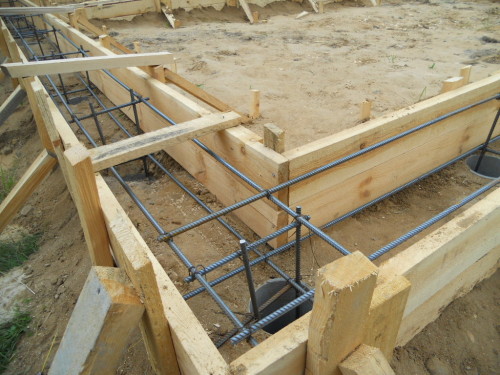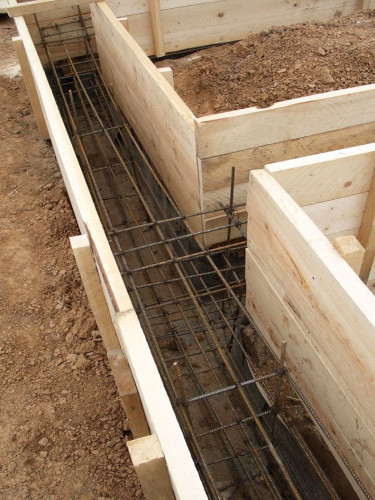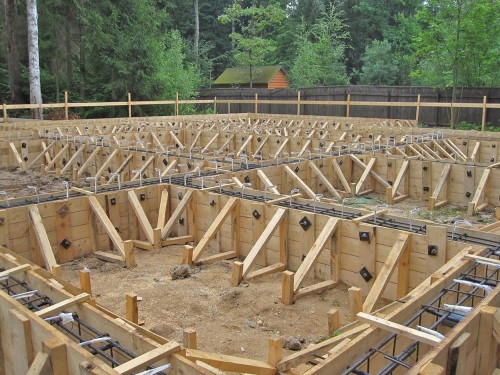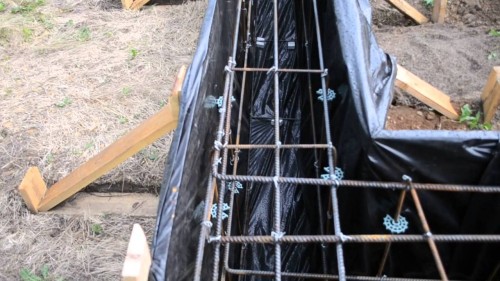As you know, concrete is an incredibly durable material, but in the case of the foundation, as well as many other concrete structures, it is simply necessary to use high -quality reinforcement. In modern conditions, it is enough to go to the construction supermarket and purchase the necessary volume of metal reinforcement. Such a solution will unequivocally strengthen the foundation, even if we have a base erected using not the highest quality solution.
Content
- The specifics of calculating the required number of reinforcement
- Determination of the right number of rods of longitudinal reinforcement
- The optimal reinforcement scheme
- Specificity of knitting reinforcement
- Features of reinforcing the angles of the strip foundation
- The remaining issues related to reinforcing the strip foundation
As for the use of reinforcement for reinforcement, in this case it is necessary to conduct a detailed calculation that allows you to install the right amount of metal elements of the base. It is worth noting in advance that in this calculation it is necessary to take into account not only the area of \u200b\u200bthe foundation, but also the specifics of its design.
In this article, we will consider the specifics of the use of reinforcement in the strip foundation. This type of foundation has its own characteristics, which we will talk about later. In addition, there are many options for creating a reinforcing frame. In some cases, builders have the opportunity to save money using smaller reinforcement. It is also very important to pay attention directly to the process of reinforcement installation itself.
The specifics of calculating the required number of reinforcement
If we are talking about calculating the reinforcement, then here you need to set the required amount of this product, its diameter and length. Moreover, on sale you can find reinforcement of different types. Often in construction stores there are the following types of products:
- reinforcement with a ring profile;
- reinforcement with a sickle profile;
- mixed reinforcement profile.
In the case of a strip foundation, builders advise using any of these types, but at the same time it is not recommended to use products on which there are no ribs. Such reinforcement is suitable for many other purposes, but with concrete it will not be seized in the best way. In turn, any ribs create a clutch with concrete, so the whole structure will be strong enough.
As for the diameter of the reinforcement, you can find a wide variety of options on sale, however, it is recommended to use metal products with a diameter of 10-20 mm to create a strip foundation. The rods that will be located vertically can have a diameter and about 6-8 mm.
After that, you need to decide on the minimum content of the reinforcement in the strip foundation. To do this, use the official SNiP standards, which presents the most authoritative data on construction work. Thus, in paragraph 7.3.5 it is indicated that the minimum content of the longitudinal reinforcement should be at least 0.1% of the total cross -sectional area of \u200b\u200bthe tape. For example, if we have a foundation with a height of 1200 mm, and 400 mm wide, then the total area of \u200b\u200bthe reinforcement cross section should be 480 mm 2. This is the minimum value that allows you to be sure of the reliability of the building structure. In the event that there is not enough reinforcement for the construction of the foundation, it is advisable to freeze the project, since subsequently an emergency situation may occur.
Determination of the right number of rods of longitudinal reinforcement
In order to determine the required amount of longitudinal metal products, you need to use the past calculations and divide the resulting value into the cross section of the selected reinforcement. Thus, we get the exact number of longitudinal rods. In this case, we can also use construction standards if some values \u200b\u200bdo not fully comply with the project.
At the same time, in SNiP you can find useful tables that allow you to determine the number of reinforcement necessary for the foundation, depending on the diameter and the total number of rods. Thus, you can first evaluate your financial expenses on the strengthening of the foundation.
The optimal reinforcement scheme
On the Internet you can find a huge number of reinforcing foundations and other concrete structures, but at the same time it is worth paying attention to precisely the simplest options that certainly will not create problems even beginners.
Experts often recommend reinforcing on a square or rectangle. Accordingly, the width of the frame should be no more than half of its height. It must be borne in mind that the strip foundation is often not tile, but very long, so the base will be subjected to more longitudinal sprains. Thus, the vertical and transverse reinforcement elements are a more constructive foundation elements.
Thus, if we chose rectangular reinforcement, then the height of the metal part of the foundation should be greater than the width. It turns out that we have 4 longitudinal lines of reinforcement. The number of transverse elements is not so important. The main thing is to make sure that the structure is reliable, and when pouring concrete there is no deformation.
Specificity of knitting reinforcement
Of course, the knitting of the reinforcement is an extremely important process, on which not only the reliability of reinforcement depends, but also the general geometric accuracy of the location of the reinforcement. Accordingly, if we are unreliable to fix the reinforcement, when pouring concrete, it can change its position. Moreover, this error will be extremely difficult to fix if the concrete is already poured and gains strength. Often, 2 methods for knitting reinforcement are used:
- With the help of wire. Yes, indeed, for such events, it is enough to use the most ordinary wire that bind the reinforcement elements. Of course, for this we will need to use a solid wire that will not be damaged by bending. It is advisable to draw a small test of the strength of the wire, since it is simply impossible to take risks when creating the foundation. Most often, about 30 cm of wire is required for the strapping of two or three reinforcements. You certainly should not be saved in this matter.
- Using welding. It is worth saying that welding for such work is used much less often, but this method of attaching the reinforcement has certain advantages. First of all, we get a reliable seam that will definitely withstand the weight of the concrete mixture. Moreover, this option of fastening allows you to be sure that the reinforcement will not shift when pouring concrete.
There are also many other options for knitting reinforcement. For example, electric hooks or screwdrivers with a special nozzle are often used.
In addition, some experts recommend using welding to connect the reinforcement only in hopeless situations, since this process slightly worsens the reinforcing properties of the reinforcement.
Features of reinforcing the angles of the strip foundation
Specialists who are engaged in various construction projects argue that reinforcing the foundation angles is the most difficult task that creates many problems. Many building standards indicate that in the corners the reinforcement, which acts as a reinforcement, should be curved. Of course, few will specifically bend the reinforcement for this process, so they often use direct material in construction.
It is reported that in this situation there is a high probability of cracks in the corners of the foundation, which subsequently creates many problems associated with the strength of the base and the entire structure.
Thus, there are two options for increasing the angles of the foundation:
- Reinforcement of Mr-shaped strengthening. In this case, curved reinforcement is used, you can use several elements at once, placing them. In this situation, reinforcement will be as effective and reliable as possible.
- Reinforcement of P-shaped strengthening. Everything is almost the same as in the case of the last option, however, the P-shaped reinforcement provides greater reliability, although more metal products will have to be used for this.
It is definitely necessary to use transverse reinforcement, which in the corners of the foundation will execute the area of \u200b\u200bthe entire design. Moreover, this issue does not depend on what angle we have - straight, sharp or dumb.
Again, you should contact the construction standards, where a lot of information is indicated directly about reinforcing the corners of the foundation. Indeed, there are many situations in which the foundation angle will have an original design.
The remaining issues related to reinforcing the strip foundation
Before proceeding with the installation of reinforcement in the strip foundation, one should consider several important issues that are definitely important in this process.
- The choice of reinforcement. As we have already said, when choosing reinforcement, you should pay attention to the diameter and other dimensions of the material. At the same time, it is better not to use smooth fittings at all. However, if necessary, smooth metal products can be used as transverse reinforcement. Separately, I would like to note that during installation it is best to use the same reinforcement. We are talking about that in the transverse compounds of the structure one reinforcement is used, and in the longitudinal ones, another, but in the same positions it is better to use the same type of product. In the event that the owners use the reinforcement of various diameters, lengths and profiles, you can encounter problems. First of all, we are talking about the load on the base. If in some place the reinforcement is less strong, and the load on the foundation will be too high, the base can be covered with cracks. Of course, this is not allowed.
- Specificity of knitting reinforcement. We have already mentioned the most common methods of connecting the reinforcement to create a reliable design. At the same time, do not forget that it is still not worth combining the connection methods. Moreover, in an overwhelming number of cases, knitting is used using wire. It is just enough to stock up on a large uuce material to reliably combine all reinforcement elements. In the event that errors are found in the design (perhaps even the smallest), the wire can simply be removed, or removed with nippers, and then fix the situation. In the case of welding, everything is much more complicated. For high -quality welding, you need money. In addition, it is obvious that after this event it will no longer be possible to change the location of the reinforcement elements. In addition, as we have already said, experts in the construction sector persistently recommend refusing to welding the reinforcement in favor of knitting with wire.
- The total strength of the structure. At first glance, the design consisting of reinforcement may seem quite durable. Moreover, even small tests can demonstrate the excellent resistance of the structure to deformations. Unfortunately, not everything is as simple as it might seem at first glance. For example, if concrete filling will occur with specialized transport (auto -my), problems associated with reinforcement stability are quite possible. During filling, a strong set and the weight of the concrete mixture can greatly affect the structure. If in some places the fastening of the wire turned out to be quite weak, it will appear immediately. Accordingly, in such a situation, you need to either check each compound, or make concrete filling manually, doing everything so that the reinforcing structure does not shift either a millimeter.
- Material consumption. We have already considered the issue related to the necessary volumes of reinforcement. It is worth saying that many owners specifically use more reinforcement so that the foundation becomes stronger. In fact, there is no positive effect of such actions, so you should use the most minimum value of the number of reinforcement, which is provided for in construction standards.













